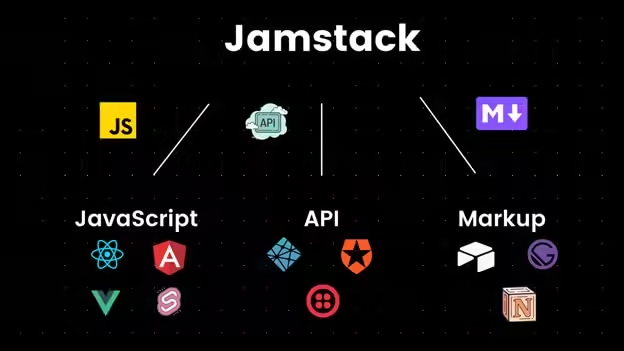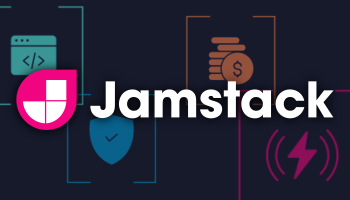As we head into 2024, JAMstack continues to revolutionize web development by offering a more modern, scalable, and efficient way to build websites and applications. This architecture, which stands for JavaScript, APIs, and Markup, is designed to decouple the front end from the back end, allowing developers to create lightning-fast, secure, and scalable web applications.
In this guide, we’ll dive into what JAMstack is, why it’s crucial for web development in 2024, and how to harness its full potential to create high-performance and flexible web apps that meet the demands of today’s users.
What Is JAMstack?
At its core, JAMstack refers to a development architecture that focuses on three main components:
• JavaScript: Handles dynamic interactions on the client side.
• APIs: Serve as the back end, managing server-side functionalities through serverless computing or microservices.
• Markup: Pre-built HTML files that are delivered through Content Delivery Networks (CDNs), ensuring fast performance.
This approach shifts away from traditional monolithic web applications where the server dynamically generates each page on request. Instead, JAMstack relies on pre-rendering and serving static files that interact with APIs for dynamic content.
Why JAMstack Matters in 2024
1. Performance and Speed
With the rise of Core Web Vitals as a ranking factor for SEO, performance is more important than ever. JAMstack websites are fast because they serve static assets via CDNs, reducing load times significantly. This makes them perfect for delivering an outstanding user experience and improving search engine rankings.
2. Scalability
One of the biggest advantages of JAMstack is its ability to scale effortlessly. Whether you’re serving content to 1,000 or 1,000,000 users, the architecture can handle it without the need for massive infrastructure changes. The static assets are served globally through CDNs, and dynamic functionalities are managed through APIs or serverless functions, allowing the app to scale automatically.
3. Security
Since there is no traditional back-end server that dynamically generates content, JAMstack apps have a smaller attack surface. This results in fewer vulnerabilities like server-side attacks or SQL injections. Additionally, serverless functions and API endpoints can be secured independently, further reducing risks.
4. Development Flexibility
JAMstack decouples the front-end from the back-end, allowing developers to choose the best tools and frameworks for each. This gives teams the freedom to innovate with cutting-edge technologies like React, Vue.js, or Svelte on the front end while using scalable, serverless functions or cloud platforms like AWS Lambda for back-end processes.
5. SEO Benefits
JAMstack applications generate pre-rendered HTML, making it easy for search engine bots to crawl and index content. With fast page loads and pre-built content, JAMstack is inherently SEO-friendly, ensuring that web apps are well-optimized for search rankings.

Key Components of a JAMstack App in 2024
To build a successful JAMstack app, you’ll need to integrate various modern technologies that align with the architecture’s principles:
1. Static Site Generators (SSGs)
SSGs like Next.js, Gatsby, and Hugo generate static HTML at build time, drastically improving performance. These tools work by pre-rendering pages based on your content and templates, ensuring that users receive lightning-fast, static content directly from a CDN.
2. Headless CMS
A headless content management system (CMS) decouples content management from front-end delivery. Popular choices include Contentful, Sanity, and Strapi, which allow you to manage content via APIs while delivering it through your JAMstack front end.
3. APIs and Serverless Functions
Rather than relying on traditional server-side code, JAMstack uses APIs to handle dynamic content and functionality. Serverless functions from providers like Netlify, Vercel, or AWS Lambda enable you to add dynamic features such as user authentication or form handling without setting up a dedicated server.
4. Content Delivery Networks (CDNs)
A critical component of JAMstack is leveraging CDNs to distribute static assets globally. Platforms like Cloudflare, Netlify, and Vercel ensure that content is served from locations closest to users, further reducing latency and enhancing performance.
Best Practices for JAMstack Development in 2024
1. Optimize Performance
Even though JAMstack is designed for speed, you should still follow best practices to optimize performance. Compress images, use lazy loading where appropriate, and minify JavaScript and CSS to ensure your site loads as quickly as possible.
2. Leverage Serverless Functions
Serverless computing is a perfect match for JAMstack, allowing you to add dynamic functionalities without the need for a dedicated server. Common use cases include form handling, user authentication, and database queries.
3. Automate Deployment with CI/CD
Use Continuous Integration and Continuous Deployment (CI/CD) tools like GitHub Actions or Netlify’s built-in deployment features to automate your build process. These tools automatically deploy your site whenever changes are pushed, ensuring your site is always up-to-date.
4. Incorporate Headless CMS for Content Management
A headless CMS provides non-technical users with a way to manage content without needing to edit code. This makes it easier for teams to collaborate on content creation while developers focus on building the front end.
5. Secure Your APIs
Security should always be top of mind when building JAMstack apps. Protect your API endpoints with proper authentication, and implement rate limiting to prevent abuse.
The Future of JAMstack in Web Development
As we move further into 2024, the importance of speed, scalability, and security will continue to drive the adoption of JAMstack. Edge computing, serverless functions, and AI-powered APIs will make it even easier to create highly dynamic, user-focused applications that outperform traditional web architectures.
We can also expect to see JAMstack integrating more with Progressive Web Apps (PWAs) and WebAssembly to create even richer, more immersive web experiences that feel like native apps. By leveraging the best aspects of front-end and back-end decoupling, JAMstack is shaping up to be the future of web development in 2024 and beyond.
Conclusion
JAMstack is more than a trend—it’s the future of modern web development. By focusing on speed, scalability, and security, this architecture allows developers to build high-performance web applications that meet the needs of today’s users. As more companies shift to JAMstack in 2024, embracing this architecture can set your projects up for success in a world that values speed and user experience above all else.
Whether you’re a startup looking for a cost-effective solution or a large enterprise seeking scalable performance, JAMstack offers the tools and frameworks to meet the growing demands of web development in 2024.
Internal Links:
• Learn more about the rise of WebAssembly and its impact on web development in 2024.
• Discover how AI is transforming modern web design for faster, more intelligent experiences.
External Links:
• Find out how to use Netlify to deploy your JAMstack site effortlessly.
• Explore more about serverless computing with AWS Lambda.

